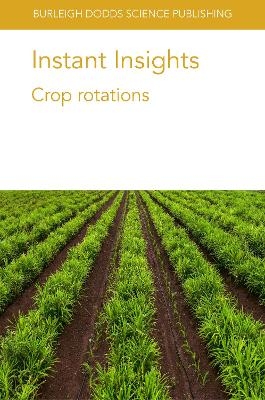
Instant Insights: Crop Rotations
Burleigh Dodds Science Publishing Limited (Verlag)
978-1-80146-059-0 (ISBN)
The first chapter discusses the effects of crop rotation and intercropping management practices and their impact on soil health enhancement and stability. It also considers the importance of leguminous crops and soil organic matter in maintaining healthy soils, sustaining crop productivity and enhancing biodiversity.
The second chapter examines the principles of crop rotation, precrop effects in crop rotations, and the nutrient effects of legumes and other rotation crops. It also reviews the role of rotation crops in suppressing weeds, diseases and pests and studies rotations and crop yields, as well as the challenge of designing a crop rotation.
The third chapter illustrates how crop models account for the interactions between soil, genotypes, management, and climate, on crops grown in various rotations, and their effects on yield and environmental outcomes under current and future climate scenarios.
The fourth chapter assesses the potential of decision support systems for crop rotations in improving soil health and agricultural sustainability.
The final chapter reviews how crop rotations with non-cereal species can be implemented to substantially reduce inoculum sources for residue-borne cereal leaf diseases.
Dr. Bruno Basso is an agro-ecosystem scientist and University Foundation Professor in Department of Earth and Environmental Sciences and W.K. Kellogg Biological Station at Michigan State University. He is a Fellow of the Soil Science Society of America and the American Society of Agronomy, and 2016 recipient of the Innovation of the year award and 2019 Outstanding Faculty Award at Michigan State University and the recipient of the 2021 Morgan Stanley Sustainable Solutions Prize. He is ranked as top 2% scientist across all disciplines and 0.006% in the field of Agronomy, Agriculture, Meteorology. He received his Ph.D. from Michigan State University.
Chapter 1 - Effects of crop rotations and intercropping on soil health: Gilbert C. Sigua, USDA-ARS, USA; 1 Introduction 2 Defining soil health 3 Indicators of soil health 4 The roles of soil organic matter in soil health 5 Managing soil health: crop rotation 6 Managing soil health: intercropping 7 Nitrogen fixation and transfer in crop rotation and intercropping 8 Summary and future trends 9 Where to look for further information 10 References
Chapter 2 - The role of crop rotations in organic farming: Bernhard Freyer, University of Natural Resources and Life Sciences (BOKU), Austria; 1 Introduction 2 Principles of crop rotation 3 Precrop effects in crop rotations 4 Nutrient effects of legumes and other rotation crops 5 The role of rotation crops in suppressing weeds, diseases and pests 6 Rotations and crop yields 7 Designing a crop rotation 8 Measuring and modelling crop rotations, nutrient and humus balances 9 Crop rotations on stockless farms 10 Conclusion and future trends 11 Where to look for further information 12 References and further reading
Chapter 3 - Modeling crop rotations: capturing short- and long-term feedbacks for sustainability and soil health: B. Basso and R. A. Martinez-Feria, Michigan State University, USA; and B. Dumont, University of Liege, Belgium; 1 Introduction 2 Reset mode crop models: the example of mitigating nitrate loss from corn-based crop rotations 3 Sequential crop models: the example of adapting crop rotations to sustain yields and soil health under climate change 4 Conclusion: improving crop rotations through modeling 5 References
Chapter 4 - Developing decision-support systems for crop rotations: Zia Mehrabi, University of British Columbia, Canada; 1 Introduction 2 Key information challenges 3 Ecological theory 4 Agronomic models 5 Encoding farmer decisions 6 Design principles 7 Outlook 8 Where to look for further information 9 References
Chapter 5 - The role of crop rotation, intercropping and tillage practices for foliar disease management of wheat and barley: T. K. Turkington, Agriculture and Agri-Food Canada, Canada; K. Xi, Alberta Agriculture and Forestry, Canada; and H. R. Kutcher, University of Saskatchewan, Canada; 1 Introduction 2 Increasing temporal diversity: crop rotation 3 Increasing spatial diversity: intercropping 4 Increasing genetic diversity: gene deployment 5 The role of conservation tillage 6 Conclusions and future trends 7 Where to look for further information 8 References
| Erscheinungsdatum | 08.03.2021 |
|---|---|
| Reihe/Serie | Burleigh Dodds Science: Instant Insights |
| Zusatzinfo | Color tables, photos and figures |
| Verlagsort | Cambridge |
| Sprache | englisch |
| Maße | 152 x 229 mm |
| Gewicht | 200 g |
| Themenwelt | Naturwissenschaften ► Biologie ► Ökologie / Naturschutz |
| Naturwissenschaften ► Geowissenschaften ► Geologie | |
| Weitere Fachgebiete ► Land- / Forstwirtschaft / Fischerei | |
| ISBN-10 | 1-80146-059-0 / 1801460590 |
| ISBN-13 | 978-1-80146-059-0 / 9781801460590 |
| Zustand | Neuware |
| Haben Sie eine Frage zum Produkt? |
aus dem Bereich


